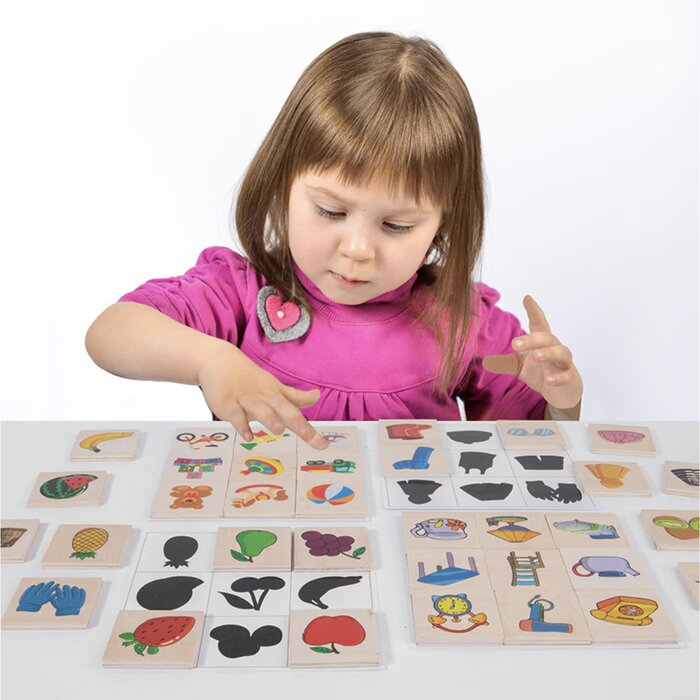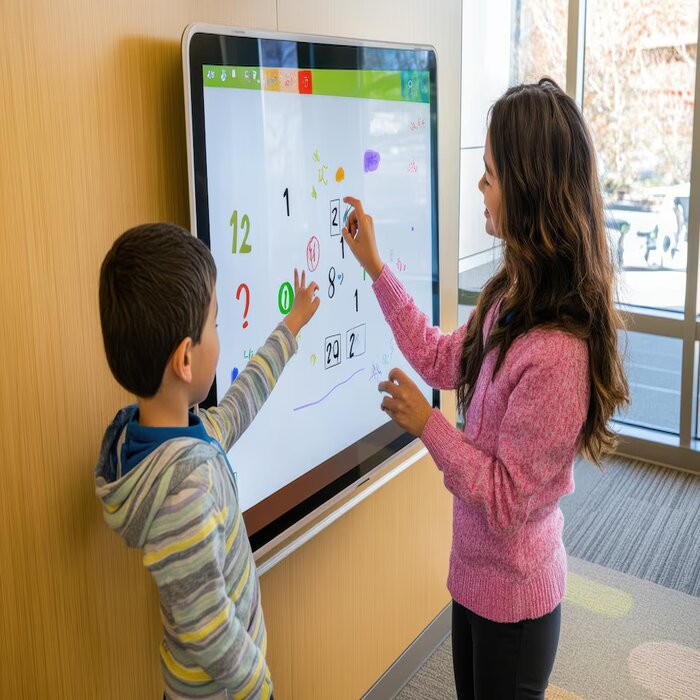

🧠 What are Augmentative and Alternative Communication (AAC) Methods?
Augmentative and Alternative Communication (AAC) encompasses a set of methods, strategies, and resources that aim to facilitate expression and comprehension in individuals who have difficulties with oral language. For autism, these methods become fundamental to enable functional communication channels, as many individuals on the spectrum have delayed or absent speech, or present atypical communicative styles. AAC does not aim to replace speech, but rather to complement it or serve as a bridge when it's not possible to use it. That is, it can be used alongside speech, or instead of it, depending on the case. These systems range from very simple resources like natural gestures or pictograms, to sophisticated electronic devices with voice output (like tablets with specific apps).
In school, family, or clinical contexts, the implementation of AAC allows the child to actively participate in their environment, expressing needs, choices, emotions, and thoughts, which improves their self-esteem, reduces frustration, and increases their quality of life. For example, a child who cannot say "I want to play outside" can use an image representing that idea and hand it to their teacher or caregiver. This small act is a huge door to their autonomy.
AAC methods also include the use of alternative languages like sign language, writing, or graphic symbols. Among the most recognized systems is PECS (Picture Exchange Communication System), which teaches individuals to use pictures to build basic sentences. There are also apps like Avaz, LetMeTalk, or Proloquo2Go, which allow for customizing communication boards. The most important thing about AAC is not the resource itself, but how it integrates into the child's daily life, allowing them to communicate effectively and meaningfully. Scientific evidence supports the use of AAC even at very early ages, demonstrating that it does not hinder oral language development, but rather promotes it by reducing anxiety and reinforcing communicative intent.
🛠 What are AAC Methods For?
Augmentative and Alternative Communication methods aren't just another tool in the field of language therapies. In many cases, they're the only way some individuals can communicate effectively. They serve multiple purposes, going far beyond simply "saying words." Firstly, they allow for establishing a clear way to express basic needs: hunger, pain, thirst, cold, heat, discomfort. This ability to voice one's needs significantly reduces tantrums, isolation, and behavioral crises that are often misinterpreted as "whims" when, in reality, they're desperate attempts to communicate.
AAC methods also foster emotional and social development, by providing tools to express complex emotions like joy, sadness, anger, or fear. For example, by using emotion cards or visual boards, children can learn to identify what they feel and communicate it, instead of expressing their distress with yelling or dysregulated behaviors. It's also possible to include phrases on boards like "I want to be alone," "I need help," "I feel bad," which contribute to creating a more understanding and less reactive environment.
Another fundamental objective is active participation in all aspects of life: family, school, community. When an environment is enabled with visual supports (e.g., a classroom with cards to ask permission or express doubt), children can integrate into group dynamics, follow instructions, answer questions, greet peers, and participate in games. This means they can exercise their right to communicate and be part of the environment, something that can be unconsciously denied to them without these tools.
Furthermore, the use of AAC methods at early ages has a direct impact on cognitive and linguistic development. They stimulate thought organization, associative capacity, visual memory, logical sequencing, and the use of symbols—all fundamental skills for both speech and later academic learning. That's why, today, experts recommend introducing AAC methods as early as possible, without waiting for speech to emerge, and always with professional support to help adapt the system to each child and situation.


⏰ When is AAC Recommended?
Multiple signs indicate the advisability of starting an approach with Augmentative and Alternative Communication methods. Firstly, its implementation is recommended when oral language doesn't appear at the expected age. For example, if a 2-year-old child hasn't yet developed functional words to communicate or doesn't show communicative intent, it's time to consult a specialist and consider using visual supports. In autism, language delay is common but shouldn't be underestimated. Early intervention with AAC can significantly change the developmental prognosis.
Another key situation is when the child cannot communicate sufficiently with words, even if they have some. That is, they say single words but cannot express what they need, feel, or want. It's also common in children with selective mutism (they speak at home but not at school) or in cases of language regression, where the child spoke and then stopped. In all these cases, AAC acts as a bridge that sustains communicative intent while working on the recovery or development of oral language.
Likewise, its use is recommended when there are frequent crises, anxiety, intense tantrums, or disruptive behaviors that seem related to an inability to communicate. Often, behind a tantrum is an unmet need, an intense emotion that cannot be verbalized, or a frustrating situation. AAC allows these emotions to be channeled in a healthier way, preventing crises and teaching self-regulation skills.
Finally, AAC methods are also used in transient situations (such as surgeries, hospitalizations, bilingual contexts) or in children with severe articulatory difficulties, apraxias, or medical conditions affecting speech production. In all these cases, the criterion shouldn't be to wait until they "speak well," but to provide them with resources from the first moment so they aren't deprived of their right to communicate.


Crises in the context of autism often have multiple causes, and it's essential to understand them from a compassionate and non-judgmental perspective. Among the most common factors that can trigger a crisis are sensory overload (loud noises, intense lights, crowds, sudden temperature changes, or unexpected physical contact), unforeseen changes in routine (like an unexpected visit, a schedule change, or an unannounced new activity), frustration from not being able to communicate what they feel or need, social or separation anxiety, and accumulated fatigue from constant stimuli that exhaust their nervous system. These factors can act in isolation or in combination, triggering behaviors like crying, screaming, aggression, intense self-stimulation, aimless running, or sudden withdrawal.
In these situations, the use of Augmentative and Alternative Communication (AAC) methods is not only useful but essential for preventing, containing, and helping to restore the emotional balance of the autistic child. One of the most effective and accessible resources is emotion cards. These cards can show facial expressions associated with basic emotions like "angry," "sad," "happy," "tired," "annoyed," "anxious," "bored," or "nervous." It's important that they are visual, simple, and made with pictograms or real images, depending on the child's level of comprehension. The goal is for the child to be able to point to or show what they feel, without having to use verbal language, which can be completely blocked during crises. These cards should be available in their backpack, at home, in the classroom, or in common areas of the home, to facilitate immediate access.
Other visual resources can also be used, such as emotion thermometers, which represent the intensity level of the emotional state (e.g., from green to red, from calm to furious), circular boards with emotional faces in a clock format, or even social stories that explain with illustrations and simple language what an emotion is, how it manifests, and what can be done to manage it. These stories help children understand that their emotions are valid and that there are healthy ways to express and regulate them.
In addition to identifying emotions, it's fundamental that the child can express what they need during the crisis, so it's recommended to teach and practice the use of visual emotional regulation phrases in advance. These phrases should be short, clear, and accompanied by images or pictograms that reinforce the meaning. Examples of useful phrases are: "I need a break," "I want to be alone," "I feel overwhelmed," "I want to leave here," "I want to be with mom," "I need my blanket," "I'm scared," "I don't want any more." It's important to teach them during calm moments, through dramatizations, symbolic play, reading stories, or songs, so that the child internalizes them as part of their communicative repertoire. It's also important that these phrases are available physically (on cards or boards) and digitally (in an app if tablet or phone communication is used).
Another extremely practical and highly effective resource is to have a prepared "regulation box" or "sensory kit," specially designed according to the child's preferences. This box should contain items the child associates with calm and comfort. Some examples include: stress balls or soft rubber balls, bubble wands, sensory dough (like slime), objects with soft textures (like fabrics or small rugs), noise-canceling headphones, warm-toned LED lights or star projectors, tactile books, spinning toys (spinners), comfort dolls, or weighted blankets. The key is to customize the box according to each child's sensory preferences, as what calms one may be indifferent or even annoying to another. This box should be located in an accessible place at home, school, or the therapist's office, and the child should learn when and how to use it as part of their self-regulation routine.
Finally, it's extremely useful to design a specific visual board for crisis situations. This board should have a calming background (colors like sky blue or mint green are ideal) and contain pictograms or images that represent concrete actions the child can take to calm down. These actions can include: "breathe deep," "count to ten," "use my headphones," "hug my stuffed animal," "drink water," "get my sensory box," "say how I feel," "sit on the mat," "go to the calm corner." This board can function as a step-by-step guide that the accompanying adult can point to with the child during the crisis. Repetition and consistency are fundamental for the child to internalize these tools and be able to use them increasingly autonomously.
It's important to emphasize that no tool works on its own if it's not accompanied by a respectful, patient, and loving attitude from the adult. During a crisis, the adult should avoid yelling, punishing, minimizing, or misinterpreting the child's behavior. Instead, they should validate their emotion, maintain a soft tone of voice, offer physical containment if desired (e.g., a hug or a hand), and calmly guide them to their safe place. Crises are not acts of defiance, but expressions of an overwhelmed nervous system. AAC allows for opening a bridge between that invisible inner world and the people who provide support, making visible what the child cannot say with words. By teaching them to communicate what they feel, by providing them with visual and sensory tools, and by building regulation routines, we are giving them a language, a structure, and an opportunity to navigate their emotions with dignity and security.


🏡 Where to Implement Augmentative and Alternative Communication (AAC) Methods?
Augmentative and Alternative Communication (AAC) methods shouldn't be limited to a single space, like therapy or home. For them to be truly effective and meaningful for an autistic person, it's fundamental that they are applied transversally in all environments where their daily life unfolds. This consistency not only favors environmental comprehension but also boosts the development of autonomy and the generalization of communicative skills. Below, we explore in depth how and why to implement AAC in different key contexts.
At Home: The First Communicative Environment
The home is, without a doubt, the most natural and emotionally significant space for any child. Therefore, the implementation of AAC resources at home must be consistent, visible, and adapted to the family routine. One of the most common and effective strategies is placing visual cards or pictograms in places where daily activities occur: for example, on the refrigerator (for choosing food), in the bathroom (to anticipate hygiene routines), in the play area (to request toys or express choices), and at the exit door (to anticipate outings or express desires like "I don't want to leave"). Additionally, personalized communication boards with phrases like "I want to watch TV," "I need to sleep," "I want to eat," etc., can be used.
It's also fundamental that the entire family actively participates in using AAC. This involves not only learning to interpret the child's systems but also modeling them naturally. For example, if the child uses pictograms to ask for water, the adult can show the "water" card before offering it, reinforcing the association. Likewise, having an emotion chart on the refrigerator can facilitate daily emotional expression, creating spaces to discuss how all household members feel. This integration strengthens family bonds, reduces frustrations, and fosters independence.
At School: A Bridge to Inclusion
School is a key environment in children's social and academic development. However, for students with autism, it can also represent a space of high communicative challenges. Implementing AAC in school is an inclusive pedagogical decision, favoring the child's active participation in the classroom and reducing misunderstandings. In this environment, visual resources can include daily visual schedules, showing what activities will happen during the day (arrival, free play, assembly, snack, etc.), to choice boards in the school cafeteria ("I want bread," "I don't want juice") or on the playground ("I want swing," "I need to rest").
It's crucial that teaching staff and assistants receive specific training on AAC. It's not just about placing pictograms, but about understanding the philosophy behind it: communication that adapts to the child, not the other way around. Teachers can model the use of pictograms when giving instructions, anticipating activity changes, or resolving peer conflicts. It's also valuable to have a calm corner with sensory regulation resources and emotion cards, which help the child identify and express what they feel before reaching a crisis.
In the Community: Building Real Accessibility
Often, communication for autistic individuals is limited outside the home or school because community spaces are not prepared to understand or respond to their ways of communicating. Therefore, it's crucial that AAC strategies also extend to contexts like public transportation, shops, health centers, parks, clubs, or restaurants. For example, cards with emergency phrases or basic needs can be prepared, such as "I want to leave," "I need help," "I feel bad," "I don't understand," which the child can carry in a pencil case, backpack, or on a lanyard.
Some families also create portable communication booklets with photos of the child, essential pictograms, and personal data (name, contact of responsible adult, allergies, etc.). These booklets can be very useful for unexpected situations or emergencies. At the community level, awareness campaigns and training in communicative accessibility can also be promoted for public-facing staff, so they recognize and respect communicative diversity.
In Therapies: Consistency Between Intervention and Daily Life
Therapy sessions (speech-language pathology, psychopedagogy, occupational therapy, etc.) are key spaces for introducing, practicing, and strengthening AAC systems. However, it's fundamental that what is worked on in the clinic has continuity at home, school, and in the community. For this, it's recommended that professionals develop personalized materials with the family and provide clear guidance on how to use them in daily life. It's also ideal for therapists to maintain a direct link with teachers, to coordinate common strategies and better support the child in their process.
The use of digital communication applications, such as LetMeTalk, Jellow, or Proloquo2Go, can be a powerful tool in the clinic, as long as it adapts to the child's cognitive and sensory needs. Additionally, it can be combined with concrete materials (like real objects or tangible cards), especially in cases of young children or those with associated intellectual disabilities. The key is to build a support network that respects the child's communicative style and provides holistic accompaniment.
Conclusion
Implementing AAC in all environments not only facilitates communication but also dignifies, empowers, and opens real opportunities for participation. When an autistic child can express how they feel, what they need, or what they want, frustration is reduced, emotional bonds are strengthened, and a more just and inclusive world is built. Communication is not a privilege; it is a right. And AAC is one of the most powerful keys to opening doors where before there were only silences or misunderstandings.


💥 What to Do in Crisis Situations?
✅ Practical Solutions for Implementing Augmentative and Alternative Communication (AAC)
The effective implementation of Augmentative and Alternative Communication (AAC) methods requires much more than simply having cards or apps available. It demands understanding, empathy, continuity, and active participation from all involved in the child's life. These practical solutions aim to build inclusive, consistent, and stimulating environments where every communication attempt is valued and supported. Below, we delve into concrete strategies that can be applied in various contexts.
🎥 Train with Videos or Visual Guides
Visual training is a transformative tool. Parents, caregivers, teachers, and even healthcare professionals often lack specific training on how to implement AAC systems, which can lead to insecurity, errors, or simply non-use. This is where videos, tutorials, and visual guides become important.
Numerous free online resources, developed by foundations, professionals, and families, explain step-by-step how to build a communication board, how to teach using a pictogram, or how to implement systems like PECS or digital boards. These videos, usually short and dynamic, offer real-life examples with children in different situations (requesting food, choosing a game, expressing an emotion), which helps visualize the concrete utility of these systems.
Using videos allows adults to learn at their own pace, repeat content as many times as necessary, and, above all, feel empowered to act. Additionally, some of these materials are designed for children to watch as well, transforming learning into a joint experience. For example, watching a video where a character uses a card to say "I need help" can motivate the child to do the same in their daily life.
🎨 Involve the Child in Card Creation
A powerful strategy is for the child to actively participate in creating their own communication materials. This process, in addition to being educational, reinforces self-esteem, comprehension, and the connection with the resource. Instead of offering a predetermined set of pictograms, the child can be invited to select images of objects they are interested in, cut out photos, paste drawings, choose colors, or even record their voice in a communication app.
When resources are built from the child's interest and active participation, their motivation to use them increases. For example, if a child really likes a specific stuffed animal, a card with a real photo of the stuffed animal can be included, instead of a generic drawing. If they prefer playing with blocks over cars, their board should reflect that preference. Thus, each card becomes meaningful, recognizable, and functional for them.
Moreover, the process of creating cards can become an integrating activity: it develops fine motor skills (cutting, pasting), vocabulary (naming what is represented), joint attention (creating with another), and planning (organizing categories: food, emotions, places). It can even be an instance of family or group play, where siblings, parents, and friends contribute ideas and collaborate.
📱 Use Free and Customizable Apps
Technological advancements have greatly facilitated access to digital communication systems. There are multiple mobile applications designed for AAC, many of them free, that allow for creating interactive visual boards, using speech synthesis, customizing pictograms, and storing frequent phrases.
Apps like LetMeTalk, JABtalk, TICO4ALL, SymboTalk, or The Grid allow content to be adapted according to the child's needs, age, and preferences. Family photos can be uploaded, familiar voices recorded, categories grouped (food, games, places, people), communication routes established, and more. Some apps even feature pictograms based on the ARASAAC system, which facilitates collaboration with therapists and educators.
Using these apps favors portability (the resource travels with the child on their tablet or phone), accessibility (the child can press a button to speak for them), and personalization (adapting language, speed, design, colors). It's not just about "saying words," but about building autonomy, reducing frustrations, and actively participating in the environment.
However, the use of technology must be accompanied by affective presence and mediation. The adult cannot delegate interaction to the device but should use it as a bridge to generate dialogues, share decisions, and validate emotions. The app is a tool, not a replacement for human connection.
🌍 Create a Unified System Across All Environments
Consistency is one of the fundamental pillars for AAC to be effective. Often, children with autism use one system at home, another at school, and a third in therapy, which leads to confusion, frustration, and demotivation. It is essential that all adults who are part of the child's environment coordinate to use the same system, the same pictograms, and the same categories.
This implies generating agreements among family, teachers, therapists, caregivers, and other significant people. For example, if it's decided to use black and white pictogram cards from the ARASAAC system, everyone should use the same images, with the same meanings. If an app is implemented, it should have the same buttons and phrases both at home and at school.
A unified system facilitates the child's learning, as they don't need to relearn symbols or constantly adapt to new codes. Additionally, it allows for language generalization: what they learn in the speech therapy room can be applied when asking for a glass of water at home. This builds a coherent, predictable, and functional communication network.
To achieve this, shared online folders with pictograms can be created, interdisciplinary meetings can be organized, printed copies of the system can be distributed, or traveler notebooks can be used to record progress, questions, or suggestions.
📌 Additional Tip: Continuous Visibility and Accessibility
One of the most common mistakes in AAC implementation is putting away materials when they are not being used. For the communication system to truly work, it must be visible, accessible, and available all the time. The child shouldn't have to "ask" for their board or cards; they should be a natural part of the environment.
This means pasting cards in key places in the house: the refrigerator, the bathroom, the bedroom, the dining table. Having a mobile board in their backpack or a keychain with pictograms hanging from their pants. Leaving the communication notebook open on the table or the app on and ready to use. When the system is always in sight, the message the child receives is: "here you can communicate all the time, like everyone else."
Furthermore, this permanent accessibility allows for reinforcing spontaneous use of the system. If the child sees the "play" card stuck near their toys, they can point to it without being prompted. If they have an "I need a hug" card on their bed, they can use it when needed, even without speaking. In this way, a truly communicative, inclusive, and respectful environment is built.
In conclusion, practical solutions for implementing AAC should focus on three pillars: accessible training for adults, active child participation, and consistency across all environments. Training with videos, building personalized cards, using appropriate technology, and creating unified systems are concrete actions that can make an enormous difference in the life of a child who needs to communicate and be understood.
Every effort on this path is a seed of autonomy, dignity, and inclusion. Communicating is a human right, and AAC is a powerful tool to guarantee it in its full dimension.


🏍️ MotoGP Rider – diagnosed with Asperger's syndrome
🔥 "My mind works differently, and that gives me an advantage on the track. Focus is my superpower." — Maverick Viñales (MotoGP rider with autism)
🧩 Free Resource for Families and Professionals
We're gifting you a PDF activity kit, ideal for children with Autism Spectrum Disorder (ASD). It includes cutout cards, games to stimulate attention, coloring activities, playful dynamics, and much more.
📚 This material has been compiled from various autism communities with the goal of sharing, supporting, and enriching learning through love and inclusion.
💖 Download it for free and start enjoying it today!
📥
Are you a Professional or Do You Provide Services Related to ASD?
At MiRutaTEA, we're developing a new section where therapeutic companions, psychologists, speech therapists, psychopedagogues, specialized teachers, and other professionals can showcase their services through our app and website.
🧩 What Will You Be Able to Offer?
Therapeutic services, school support, or stimulation.
Workshops, group activities, or intervention proposals.
Links to your social media or professional website.
Contact information so families can easily find you.
💙 How to Join?
We'll soon launch a low-cost monthly subscription system so you can be part of our community. In the meantime, you can complete the contact form and tell us about your work.
🚀 Join a Network Designed to Connect Families with Professionals Committed to the Inclusion and Well-being of Individuals with ASD.
🔗 One Click Makes a Difference
Follow us on social media and help us reach more families with information about autism and alternative communication.
📲 Your support means a lot! 👇
💙 At MiRutaTea, we believe in the power of every voice.
Your experience can support, inspire, and help someone feel less alone.
🧩 Click the button and join the blog: read, share, and be part of the conversation.
This space is yours too.
